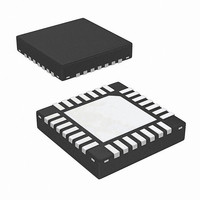ISL62881CHRTZ Intersil, ISL62881CHRTZ Datasheet - Page 18

ISL62881CHRTZ
Manufacturer Part Number
ISL62881CHRTZ
Description
IC REG PWM SGL PHASE 28TQFN
Manufacturer
Intersil
Datasheet
1.ISL62881CHRTZ.pdf
(37 pages)
Specifications of ISL62881CHRTZ
Applications
Controller, Intel IMVP-6.5™
Voltage - Input
4.5 ~ 25 V
Number Of Outputs
1
Voltage - Output
0.0125 ~ 1.5 V
Operating Temperature
-10°C ~ 100°C
Mounting Type
Surface Mount
Package / Case
28-VQFN
For Use With
ISL62881CCPUEVAL2Z - EVAL BOARD ISL62881CCPU 28QFN
Lead Free Status / RoHS Status
Lead free / RoHS Compliant
Available stocks
Company
Part Number
Manufacturer
Quantity
Price
Part Number:
ISL62881CHRTZ
Manufacturer:
INTERSIL
Quantity:
20 000
Part Number:
ISL62881CHRTZ-T
Manufacturer:
INTERSIL
Quantity:
20 000
As Figures 1 and 2 show, a resistor R
the IMON pin to convert the IMON pin current to voltage.
A capacitor can be paralleled with R
voltage information. The IMVP-6.5™ specification
requires that the IMON voltage information be referenced
to VSS
The IMON pin voltage range is 0V to 1.1V. A clamp circuit
prevents the IMON pin voltage from going above 1.1V.
Adaptive Body Diode Conduction Time
Reduction
In DCM, the controller turns off the low-side MOSFET
when the inductor current approaches zero. During
on-time of the low-side MOSFET, phase voltage is
negative and the amount is the MOSFET r
drop, which is proportional to the inductor current. A
phase comparator inside the controller monitors the
phase voltage during on-time of the low-side MOSFET
and compares it with a threshold to determine the
zero-crossing point of the inductor current. If the
inductor current has not reached zero when the low-side
MOSFET turns off, it’ll flow through the low-side MOSFET
body diode, causing the phase node to have a larger
voltage drop until it decays to zero. If the inductor
current has crossed zero and reversed the direction when
the low-side MOSFET turns off, it’ll flow through the
high-side MOSFET body diode, causing the phase node to
have a spike until it decays to zero. The controller
continues monitoring the phase voltage after turning off
the low-side MOSFET and adjusts the phase comparator
threshold voltage accordingly in iterative steps such that
the low-side MOSFET body diode conducts for
approximately 40ns to minimize the body diode-related
loss.
Overshoot Reduction Function
The ISL62881C has an optional overshoot reduction
function, enabled or disabled by the resistor from the
COMP pin to GND, as shown in Table 3.
When a load release occurs, the energy stored in the
inductors will dump to the output capacitor, causing
output voltage overshoot. The inductor current
freewheels through the low-side MOSFET during this
period of time. The overshoot reduction function turns off
the low-side MOSFET during the output voltage
overshoot, forcing the inductor current to freewheel
through the low-side MOSFET body diode. Since the body
diode voltage drop is much higher than MOSFET R
voltage drop, more energy is dissipated on the low-side
MOSFET therefore the output voltage overshoot is lower.
If the overshoot reduction function is enabled, the
ISL62881C monitors the COMP pin voltage to determine
the output voltage overshoot condition. The COMP
voltage will fall and hit the clamp voltage when the
output voltage overshoots. The ISL62881C will turn off
LGATE when COMP is being clamped. The low-side
MOSFET in the power stage will be turned off. When the
output voltage has reached its peak and starts to come
down, the COMP voltage starts to rise and is no longer
SENSE
.
18
imon
imon
to filter the
ISL62881C, ISL62881D
ISL62881C, ISL62881D
is connected to
DS(ON)
voltage
DS(ON)
clamped. The ISL62881C will resume normal PWM
operation.
While the overshoot reduction function reduces the
output voltage overshoot, energy is dissipated on the
low-side MOSFET, causing additional power loss. The
more frequent the transient event, the more power loss
is dissipated on the low-side MOSFET. The MOSFET may
face severe thermal stress when transient events happen
at a high repetitive rate. User discretion is advised when
this function is enabled.
Key Component Selection
R
The ISL62881C uses a resistor (1% or better tolerance is
recommended) from the RBIAS pin to GND to establish
highly accurate reference current sources inside the IC.
Using R
application and using R
GPU core application. Do not connect any other
components to this pin. Do not connect any capacitor to
the RBIAS pin as it will create instability.
Care should be taken in layout that the resistor is placed
very close to the RBIAS pin and that a good quality
signal ground is connected to the opposite side of the
R
Inductor DCR Current-Sensing Network
Figure 13 shows the inductor DCR current-sensing
network. An inductor current flows through the DCR and
creates a voltage drop. The inductor has a resistors in
R
trace connected to the output-side pad to accurately
sense the inductor current by sensing the DCR voltage
drop. The sensed current information is fed to the NTC
network (consisting of R
C
thermistor, used to temperature-compensate the
inductor DCR change. The inductor current information is
presented to the capacitor C
BIAS
sum
n
BIAS
. R
FIGURE 13. DCR CURRENT-SENSING NETWORK
ntc
connected to the phase-node-side pad and a PCB
DCR
resistor.
BIAS
PHASE
L
IO
is a negative temperature coefficient (NTC)
= 147kΩ sets the controller for CPU core
RSUM
RNTCS
RNTC
bias
ntcs
RP
= 47kΩ sets the controller for
, R
n
. Equations 7 through 11
ntc
and R
CN
+
-
RI
p
) and capacitor
VCN
ISUM+
ISUM-
March 8, 2010
FN7596.0












